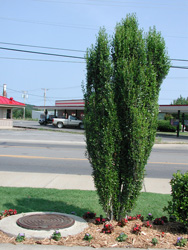Resource Library
Plant of the Week: Sky Pencil Holly
The University of Arkansas System Division of Agriculture does not promote, support or recommend plants featured in "Plant of the Week." Please consult your local Extension office for plants suitable for your region.
Plant of the Week
Sky Pencil Holly
Latin: Ilex crenata

When I first began learning about plants almost 40 years ago, I thought in terms of generalities, glossing over the differences between individuals. But the garden world is about specifics, not generalities. Except for a few seed-grown shade trees and wildflowers, gardening revolves around the cultivar and its unique characteristics. I first learned Japanese holly in its general sense as "big round bush," but that all changed when Sky Pencil arrived.
Ilex crenata 'Sky Pencil' is an 8- to 10-foot tall evergreen holly that grows like a narrow exclamation mark only 12 to 18 inches across. At maturity it may put on a bit of weight around the middle, but so far has not exceeded 2 feet in diameter. Branching is strong and plants do not develop the "fallen out" branches of some fastigiate plants.
Sky Pencil has elliptical, spine-free leaves about 1½ inches long that resemble the typical form. Small greenish white flowers are produced in late spring but are of no ornamental significance. In the fall black, pea-sized berries may be produced on this female clone, but they are hidden in the foliage.
Japanese hollies were first introduced to the garden world from Japan, so they bear that name, but they are native over a wide swath from Korea throughout Japan, Taiwan, coastal parts of China, parts of the Philippines and into the Himalaya mountains. A botanist, Carl Maximovicz from the Botanical Garden in St. Petersburg, Russia, introduced Japanese holly to western gardens in 1864 following his four-year ramble in Japan. However, none of his introductions made it to the United States. It was Charles Sargent of the Arnold Arboretum in Boston, Mass. who procured living plants during his visit to Japan in 1898. Japanese holly and other broadleaf evergreens didn't become an important part of the American landscape until after World War II, when container growing and better roads made widespread distribution possible.
Sky Pencil though is a thoroughly Japanese plant. It was discovered in the wild on Mount Daisen, Honshu, Japan by Norihiro Shibamichi. He shared cuttings of the plant with Dr. Masato Yokoi, a noted collector and author on variegated plants. In 1985, Dr. Yokoi shared cuttings with Sylvester March of the U.S. National Arboretum and Frederick Darke of Longwood Gardens in Pennsylvania during their collaborative plant collection foray into Asia. In 1992, the National Arboretum released cuttings to the nursery trade.
The fastigiate growth form is a useful but problematic shape in the garden. Plants can be used as a narrow, living hedge, but to do so requires spacing plants very close together. More commonly, the narrow form is used as an accent in the landscape – with plants used to accent entryways, the ends of a border or other spaces where a vertical accent makes sense. It is also useful as a container plant, where it can serve as a vertical marker in a plant grouping. If used in a container, plants must be protected over winter, because the roots will be winterkilled when temperatures drop much below 20 degrees Fahrenheit.
Japanese hollies require a well-drained, slightly acidic soil with a good base of organic matter. Plants will tolerate short periods of drought once established, but prolonged drought periods are not recommended. They are best in full sun or light to moderate shade. Japanese hollies are best in USDA zones 7 through 9.
Pursuant to 7 CFR § 15.3, the University of Arkansas System Division of Agriculture offers all its Extension and Research programs and services (including employment) without regard to race, color, sex, national origin, religion, age, disability, marital or veteran status, genetic information, sexual preference, pregnancy or any other legally protected status, and is an equal opportunity institution.
By: Gerald Klingaman, retired
Extension Horticulturist - Ornamentals
Extension News - June 4, 2010
The University of Arkansas System Division of Agriculture does not maintain lists of retail outlets where these plants can be purchased. Please check your local nursery or other retail outlets to ask about the availability of these plants for your growing area.